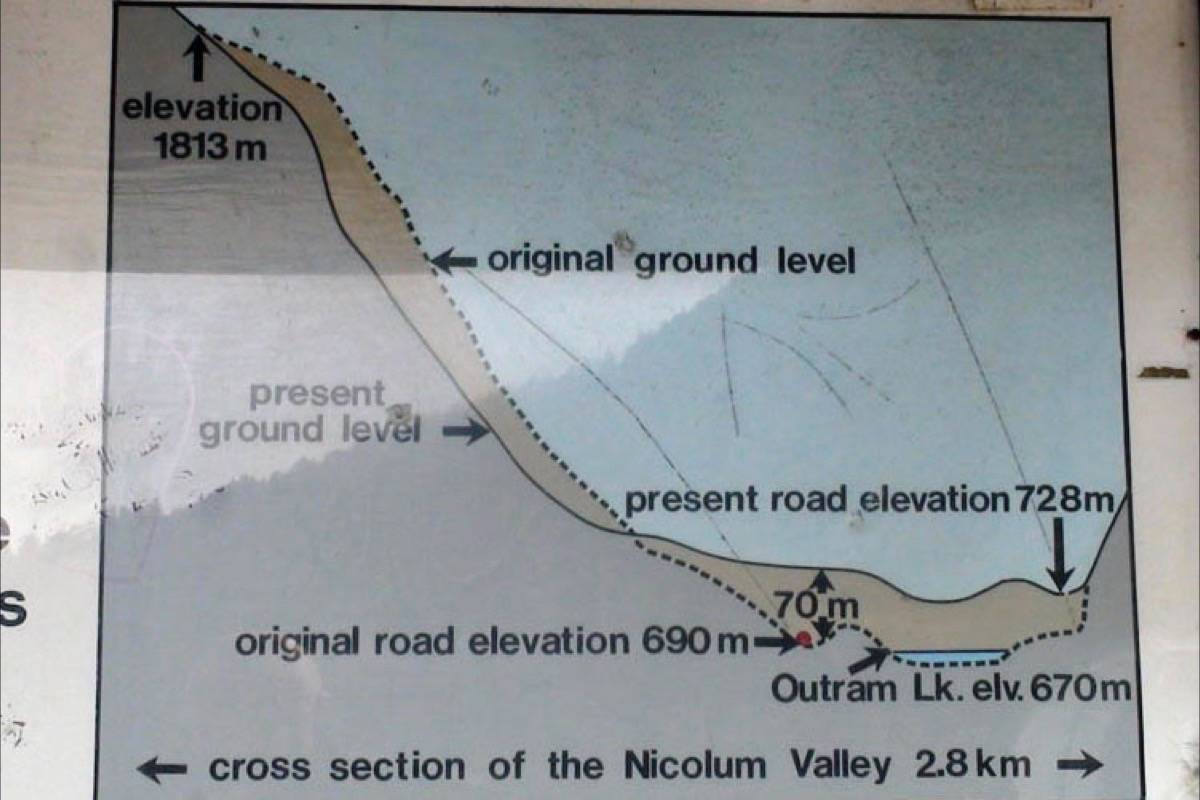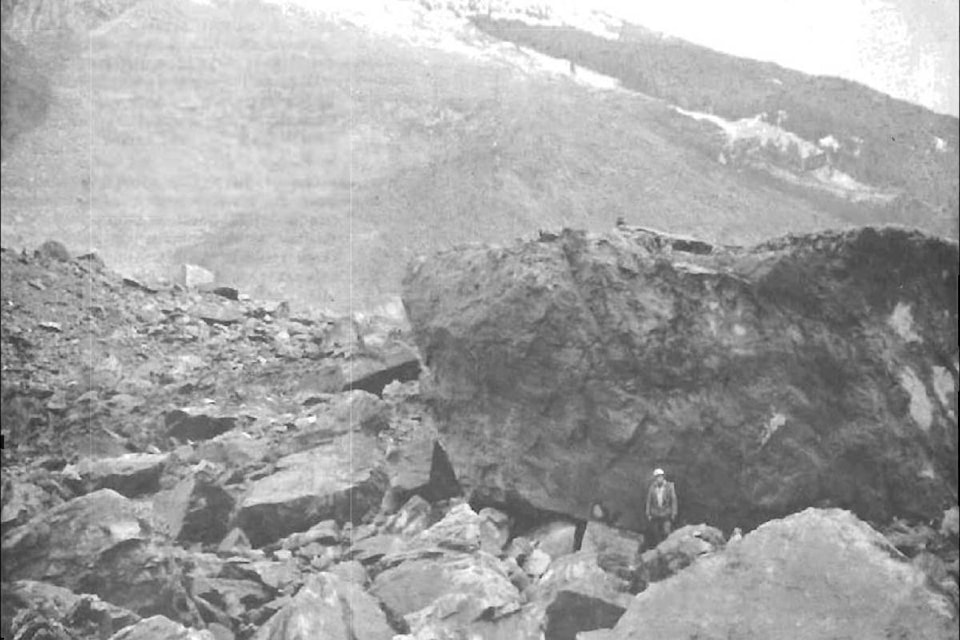At 3:56 a.m. on January 9, 1965, the first of two slides 24 km/15 miles east of Hope stopped five people in their trips westward: 27-year-old Bernie Lloyd Beck and his passengers Dennis Arlitt (23) and Mary Kalmakoff (21); truck driver Norman “Steph” Stephanishin; and 39-year-old truck driver Thomas Starchuk.
The yellow Ford convertible in which Beck, Arlitt, and Kalmakoff were travelling hit, and got stuck in, the slide; Stephanishin came upon them at around 4:45 a.m., followed by Starchuck a short time later. The two truckers could not turn their rigs around on the narrow highway, and Starchuk elected to stay in his cab and get some sleep. Beck and Arlitt tried to dig the car out, and Stephanishin decided to walk back to Sumallo Lodge, 5.5 km/3.5 miles east.
On his way he flagged down a westward-bound Greyhound bus driven by David Hughes, and explained the situation. Hughes headed back to the Lodge, where the men alerted Bob Sowden, who drove to the slide site, assessed the situation, and then turned eastward to alert Department of Highways crews at Allison Pass, 38.5 km/24 miles east.
The second slide, at 6:58 a.m., brought a wave of debris down the side of Johnson Peak, across the highway, and up the slope of Mount Coulter to the south, sweeping up the contents of Outram Lake (also known as Beaver Lake) in its path. The huge mass hung there for a moment, then flowed back down into the Nicolum Valley, spreading 47 million cubic metres of debris along the highway.
Bernie Lloyd Beck, Dennis Arlitt, Mary Kalmakoff, and Thomas Starchuck did not stand a chance.
The convertible, Steph’s Kenworth truck, trailer, and pup, and Starchuk’s tractor and hay trailer were swept up in the slide and tossed around like toys, as were a loader and shovel at a nearby Highways Department gravel pit. Outram/Beaver Lake was obliterated, and two cabins were also destroyed.
Shortly after 7 a.m. Stephanishin, waiting anxiously at Sumallo Lodge and worried about the travellers, decided to go and see how those at the slide site were doing. Len Lloyd, who was driving a CPR mail truck and had been stopped by Steph at the lodge, drove him west towards where he had parked his rig.
The first hint that something terrible had happened came when they were blocked by a slide half-a-mile east of the initial slide that had stopped the five travellers. Both men then noticed, in the thin light of dawn, that high above them to their right the slope of Johnson Peak was dark brown, not white with snow. Steph wanted to climb over the slide and keep moving forward, to where the vehicles had been left, but Lloyd urged him to wait until it got lighter.
As the morning sun illuminated the scene, the men saw that Johnson Peak looked as if someone had taken a massive axe to it and cleanly shorn away the side. To their left, the side of Mount Coulter had been stripped of trees to a height of 150 m/500 feet, and was stained a muddy brown colour. The peaceful, treed valley had disappeared, and in its place was an ocean of boulders, tree trunks, snow, and mud that had obliterated all trace of the highway and buried the valley floor in up to 70 m/200 feet of debris for three kilometres.
Bob Sowden and a second Greyhound bus driver who had stopped at Sumallo Lodge arrived at the site and Sowden—one of the founders of Hope Search and Rescue—climbed up the edge of the slide to see if there were any survivors, while the other three headed back to the lodge to get more help. They asked the waitress there for the key to the radio room, but she did not have one, so Stephanishin returned to the slide site to get one from Sowden.
He got there in time to see Sowden, who he later described as “white as a ghost,” making his way back through waist-deep snow. The trained rescuer had been trying to find a firm path so that he could reach higher ground, get a better view of the magnitude of the disaster, and look for any signs of survivors, but another small slide had sent debris plummeting down Johnson Peak, and he had been forced to turn back and hastily retrace his path. “The ground was shaking so much I was falling down with every step,” he later explained, and told Steph that it was too dangerous to try to move forward. He added that the whole valley seemed to have been buried.
The Highways Department crew that had been assembled to deal with what they thought was a minor slide had now arrived, and immediately realized the enormity of what faced them. Jack Chalmers, the head of the crew, drove back to a high point on the highway to try to get a radio message out to Highways Minister Phil Gaglardi, but the mountainous terrain made transmission difficult.
Until then only a handful of people, most of whom were at the slide site, knew about the full extent of the tragedy that had unfolded in the Nicolum Valley. The bus passengers only a short distance away at Sumallo Lodge, many of whom were eating breakfast, only knew that the road was blocked by what they assumed was a minor slide. RCMP Cpl. Leonard Brown, in charge of the Princeton detachment—and also a member of Princeton Search and Rescue—had received a call for assistance, but it had stated merely that some motorists had been trapped in a slide.
However, radio operators in the area, hearing snatches of Chalmers’ messages, began piecing together what was going on, and broke into the transmissions asking for more information. Norm Stephanishin arrived in Princeton aboard David Hughes’s Greyhound bus and gave Brown a first-hand account of the scale of the disaster. Brown quickly mobilized members of Princeton Search and Rescue to head to the site.
Back at Sumallo Lodge, the various vehicles that had been stopped there turned around to head east, as rescuers headed west. The odds of finding anyone alive were slim, and the identities of those caught up in the slide were a mystery. If they could not find any survivors, the rescuers knew they could at least try to find, and identify, those who had been lost.
To be continued

